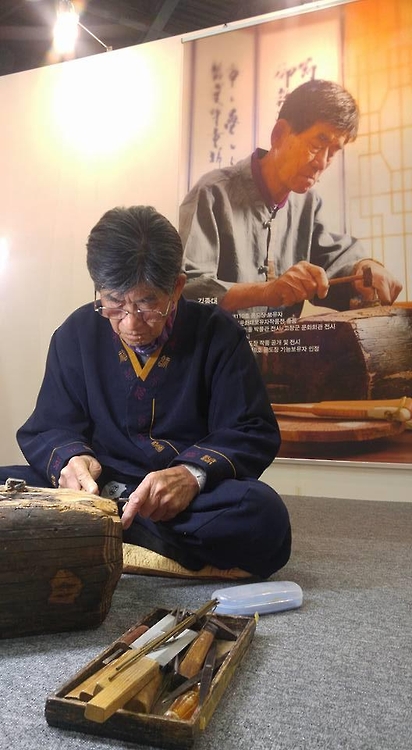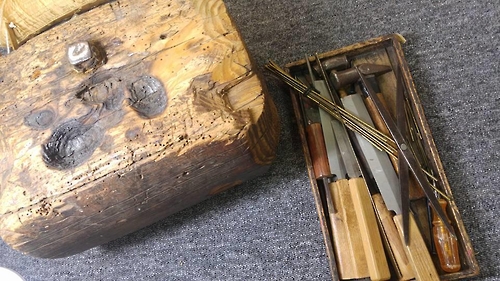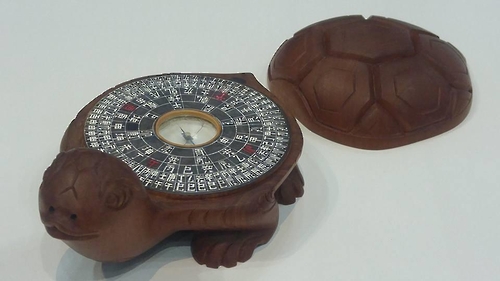- California Assembly OKs highest minimum wage in nation
- S. Korea unveils first graphic cigarette warnings
- US joins with South Korea, Japan in bid to deter North Korea
- LPGA golfer Chun In-gee finally back in action
- S. Korea won’t be top seed in final World Cup qualification round
- US men’s soccer misses 2nd straight Olympics
- US back on track in qualifying with 4-0 win over Guatemala
- High-intensity workout injuries spawn cottage industry
- CDC expands range of Zika mosquitoes into parts of Northeast
- Who knew? ‘The Walking Dead’ is helping families connect
Meet Korea’s sole geomantic compass maker
SEOUL, Nov. 11 (Yonhap) — As his vision is getting notably dim and his back aches from sitting for so long, it becomes increasingly hard for Kim Jong-dae to continue his life-long work these days.
But Korea’s only master artisan of “Yundo,” or a geomantic compass, proudly said to Yonhap News Agency on Friday that he has never regretted inheriting his family’s legacy.
“It’s been around 330 years since our village started making this compass generation after generation. I couldn’t possibly say ‘no’ to my uncle’s will that I succeed this from him,” Kim said, sitting on a makeshift podium to demonstrate the time-honored craftsmanship to visitors to the first “Grand Exhibition of Korean Intangible Cultural Heritages.”

Kim Jong-dae, South Korea’s master artisan to make “Yundo,” or a geomantic compass, demonstrates his work at the Grand Exhibition of Korean Intangible Cultural Heritages in the Korea International Exhibition Center (KINTEX) in Goyang, north of Seoul, on Nov. 11, 2016.
The event, taking place this weekend in the Korea International Exhibition Center (KINTEX) in Goyang, north of Seoul, was organized by several government agencies, with a mission to preserve Korean tradition and culture, to showcase the country’s traditional craft works made by intangible cultural assets. It is also aimed at diversifying people’s experiences with traditional craftsmanship outside a museum.
As the highlight of the event, 25 craftsmen show visitors how they create their works, ranging from tying a knot to making hanji, or traditional Korean handmade paper.
The traditional direction finder “Yundo,” which was also used to read geomancy, is very complicated and delicate to make.

The photo shows Kim Jong-dae’s tools that have been passed down for several generations. It is taken at the Grand Exhibition of Korean Intangible Cultural Heritages in the Korea International Exhibition Center (KINTEX) in Goyang, north of Seoul on Nov. 11, 2016.
The physically grueling process involves cutting trees — mostly jujube trees for its hardness — and carving onto the rock-hard surface symbols and formulas, such as Yin and Yang, the Five Elements and the Eight Trigrams, that point to directions and geomancy according to the lunar calendar.
Kim’s hands — rough, callused, and cracked — seem to demonstrate the physical hardship of etching delicate and tiny symbols and letters onto such a solid surface.
Now 82, Kim said while he now feels deeply proud of his decision he made at 28, he wouldn’t have ditched a stable job at a local bank if he hadn’t felt so pressed to carry the family tradition, he admitted. Moreover, a sense of urgency that if he hadn’t, nobody would made him take the job.
“Financially speaking, we suffered a lot of hardships. Making this compass isn’t helpful at all in supporting my family,” said the artisan who lives in Gochang, North Jeolla Province, and was designated in 1996 as the country’s intangible cultural asset No. 110.

A turtle-shaped “Yundo,” or a geomantic compass, by Kim Jong-dae is shown in the photo taken at the Grand Exhibition of Korean Intangible Cultural Heritages in the Korea International Exhibition Center (KINTEX) in Goyang, north of Seoul on Nov. 11, 2016.
But the economic difficulties pale in comparison to the level of satisfaction and pride that he and his family feel.
Now his son and grandson are officially learning the ropes from Kim.
His son, Kim Hee-soo, who was helping his father at the site, said it is a sense of duty that keeps them going.
“No one comes forward to learn it. Given it takes at least five years for anyone to start making it on their own and you can’t make money out of this, who would be willing to do this?” asked the son, who also works on land to supplement the family’s income.
“We feel it is our mission to hand down this cultural heritage that started from early Joseon era (1392-1910) to generations to come,” he said.











